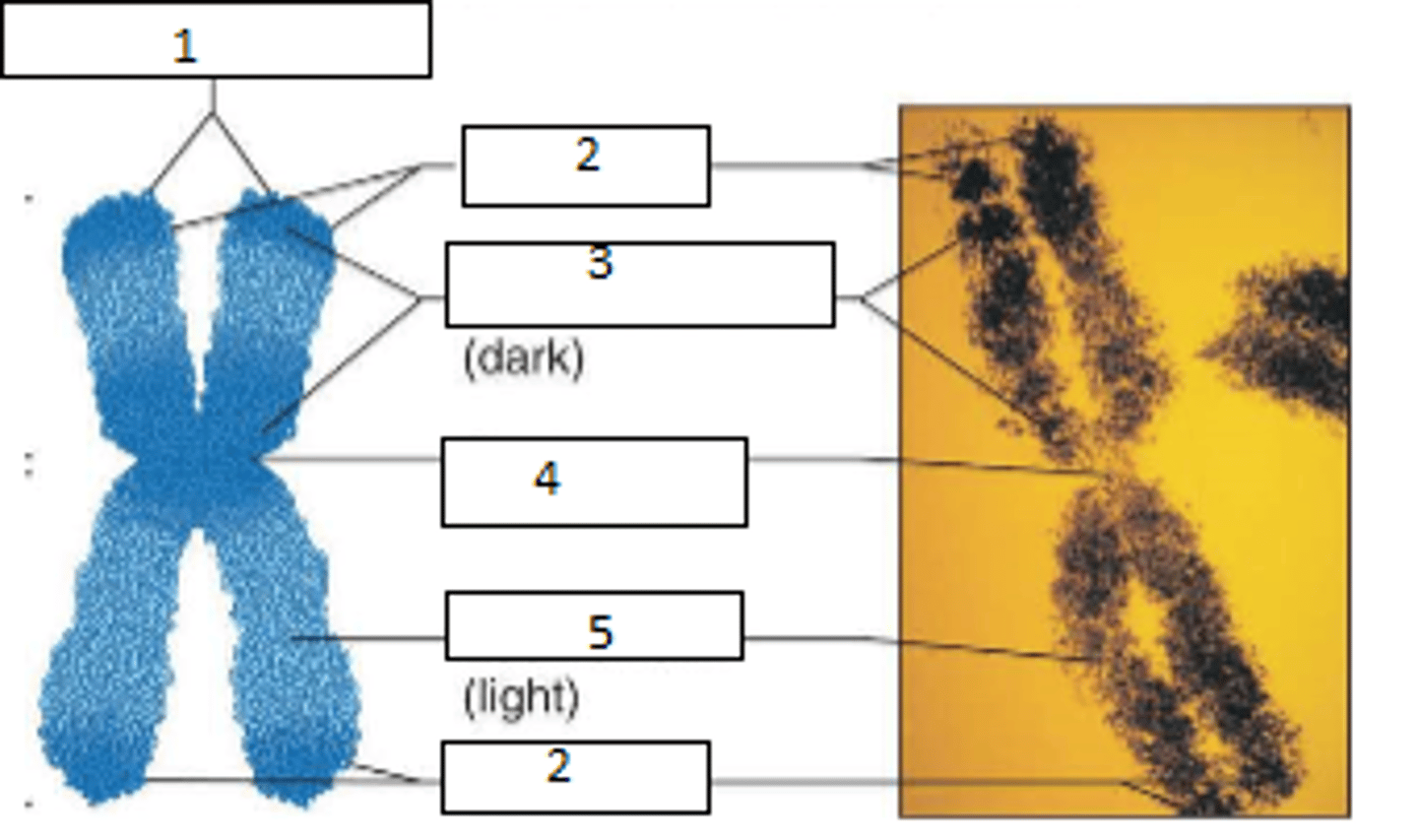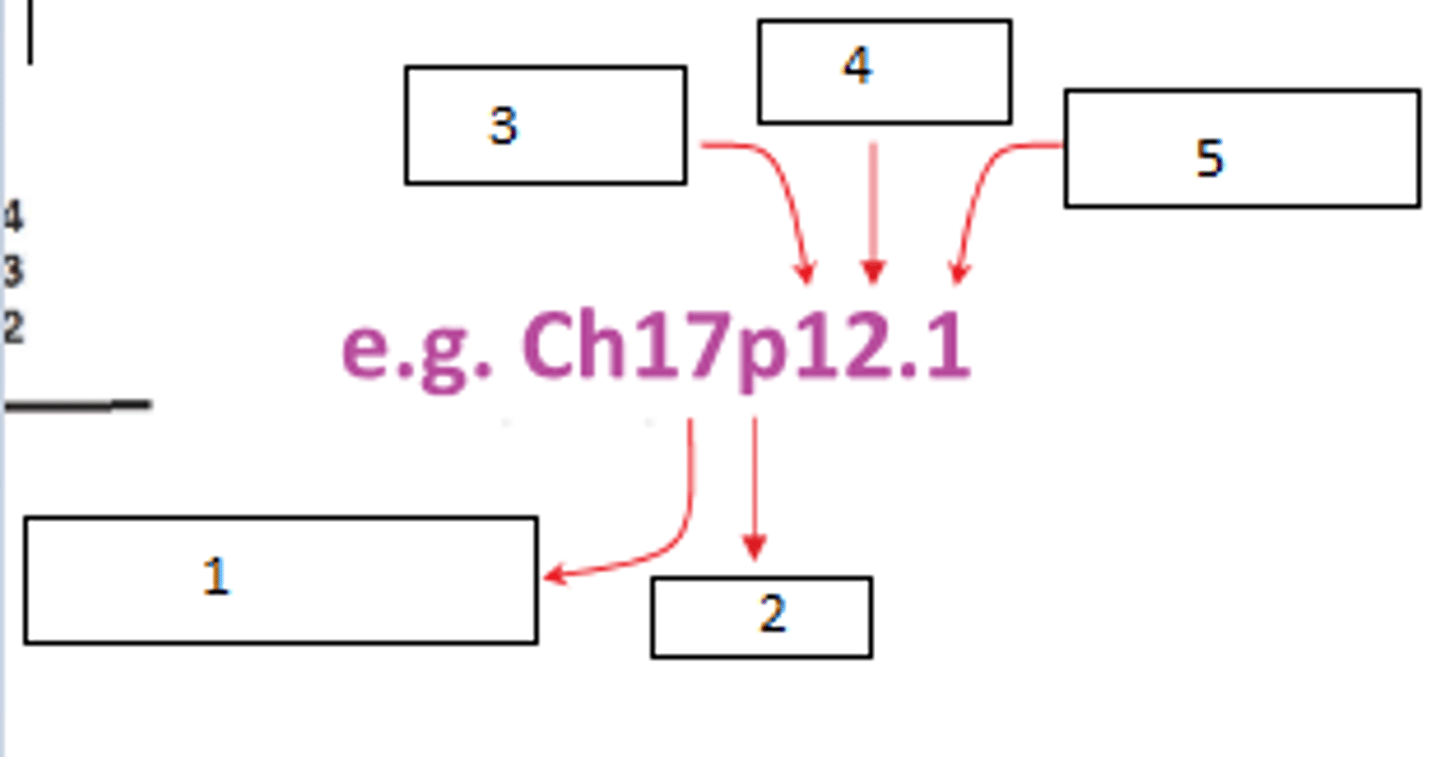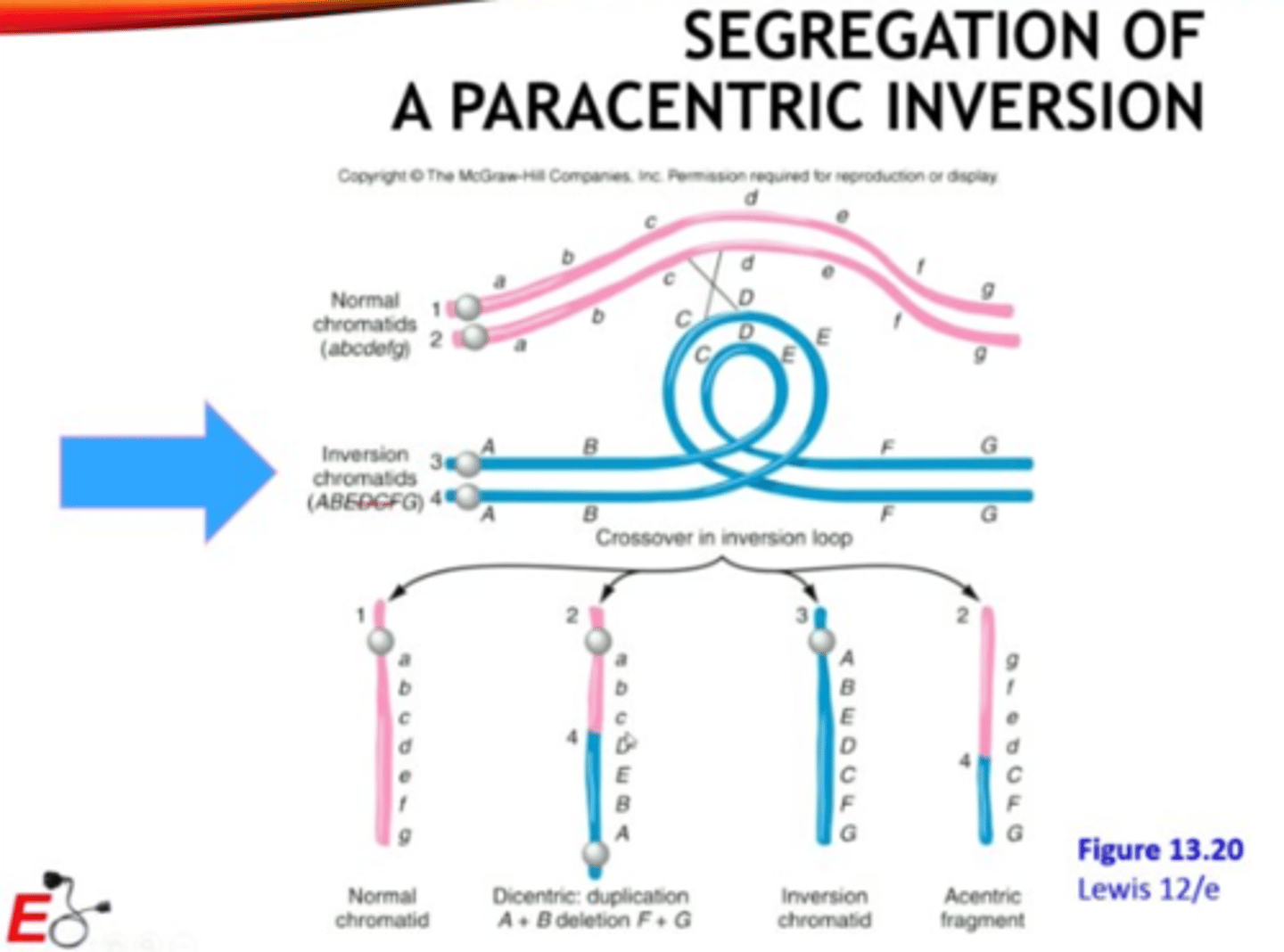G&H Lecture 2 + GLS Lecture
1/80
There's no tags or description
Looks like no tags are added yet.
Name | Mastery | Learn | Test | Matching | Spaced |
|---|
No study sessions yet.
81 Terms
It is the visible collection of an individuals complete genetic material
What is a karyotype?
Chromosomes other than sex chromosomes
What are autosomes?
Single nucleotide polymorphisms - changes in a single base pair
What are SNPs?
Copy number variants - variations in the number of a certain gene
What are CNVs?
sister chromatids,
telomeres,
heterochromatin,
centromere,
euchromatin
Fill the blanks

By their distinct banding patterns of hetero- and euchromatin
How could you tell apart two very similar sized chromosomes and know their number?
isolation of fetal cells from maternal blood,
amniocentesis,
chorionic villi sampling
What are 3 ways of sampling fetal cells to test for genetic abnormalities?
It is the sampling of amniotic fluid for health tests
What is amniocentesis?
It is the sampling of chorionic villi from the placenta for health tests
What is chorionic villi sampling
- Sampling (least invasive is from maternal blood)
- centrifuge sample to isolate layers of leukocytes
- grow isolated cells in medium (flask with nutrients)
- treat cell mixture with a cell cycle inhibitor (colchicine - spindle inhibitor)
- break cells (eg drop from 2 feet onto slide)
- examine microscopically (or using more sophisticated methods such as FISH)
What are the general steps to testing the foetal karyotype for genetic abnormalities?
Once isolated, the karyotype is dyed with Giemsa. This stains heterochromatin dark and euchromatin light. The karyotype is then scanned, chromosomes are cut out and aligned by size to determine their number. Their specific banding patterns allow confirmation of their number
Explain how traditional G-banding works
Spectral karyotype analysis - each chromosome is labelled with a specific dye, identifying them by colour
What is SKY?
Chromosome number does not indicate complexity, however closely related species tend to have similar numbers
What is the relevance of chromosome number for an organism?
relaxed,
condensed,
active,
silent,
early S-phase,
late S-phase
Fill the blanks

constitutive: condensed in all cells
facultative: condensed in some cells
What is the difference between constitutive heterochromatin and facultative heterochromatin?
Generally, the more specialised the more heterochromatin. This is because fewer genes need to be accessed and expressed
What is the relationship between euchromatin:heterochromatin ratio and cell differentiation?
chromosome,
arm,
region,
band,
sub-band
Fill the blanks

centromere is in the centre - p and q arm are almost the same length
What is a metacentric chromosome?
centromere is slightly off-centre - p and q arm are not hugely different in length
What is a submetacentric chromosome?
This is a chromosome which has a very short p arm and a very long q arm, in comparison to each other
What is an acrocentric chromosome?
A non-expressed protective 'cap' at the end of each arm of a chromosome which is made up of repetitive sequences and shortens over the lifespan
What is a telomere?
constitutional: affect every single cell and happen during gamete formation
acquired: develop during early mitotic stages of embryo development and affect some cells and regions but not others
What is the difference between acquired and constitutional chromosome abnormalisties?
In this type of mitotic failure, one chromatid fails to migrate toward its pole. The chromatid lags behind in anaphase and is excluded from the new cell. This produces one health cell and one cell which is missing a chromosome
Describe anaphase lag
non-disjunction is when, during meiotic division, chromosomes are not split and both copies end up in 1 daughter cell, leaving the other with no copy. If this happens at meiosis 1, there will be two 'incomplete' daughter cells and two with an extra copy. If it happens at meiosis 2, there will be one of each. If a double chromosome gamete joins with a normal gamete, the resulting cell with be trisomic (3 copies of a chromosome). If an 'incomplete' gamete joins with a normal gamete, the resulting cell will be monosomic.
Explain non-disjunction and potential outcomes
The addition or loss of chromosomes or parts of chromosomes. an(not)eu(normal)ploidy(ploid = number of chromosome copies)
What is aneuploidy?
non-disjunction
What is the most common cause of aneuploidy?
trisomy, extra information is generally detrimental but more compatible with life than missing information
What kind of aneuploidy is more common and why?
addition of whole sets of chromosomes
What is polyploidy?
generally, the embryo won't develop. exceptions are chromosome 18 and 21, as they are small and contain less genetic information
What is the general prognosis for trisomy?
Generally embryonically lethal, with exception of sex chromosomes as these have less genetic information
What is the general prognosis for monosomy?
Edwards Syndrome
What is the condition caused by trisomy 18
Down Syndrome
What is the condition caused by trisomy 21
Klinefelter's syndrome
What is the condition caused by XXY
Turner's Syndrome
What is the condition caused by X0 (0=no chromosome)
60% ( most common: trisomy -> 45XO, triploid -> tetraploid -> other)
What percentage of early spontaneous abortions show an abnormal karyotype?
spontaneous abortion
What does trisomy 10, 15, and 16 usually cause?
karyotype: 45 chromosomes, male, missing chromosome 22
Interpret 45, XY, -22
normal female karyotype
Interpret 46, XX
Only 1 X chromosome is used, including females. The remaining becomes hypercondensed into a "Barr body"
How can males survive without having a second X chromosome?
47, XXY (Klinefelter syndrome)
What is an exception to X inactivaion in males?
This happens when genes are expressed in some cells but not others. Generally as a consequence of acquired chromosomal abnormalities. eg: ectodermal dysplasia in women - patches of skin lack sweat glands and hair due to mosaic X inactivation
What is a mosaic for expression of genes?
47, XXY - develop male breats (gynecomastia), hypogonadism and show other subtle abnormalities
Describe Klinefelter's syndrome
45, X0 - This is often embryonically lethal. Most survivors are mosaics with a substantial number of 46,XX cells.
Describe Turner's syndrome
- errors during gamete formation, where genetic material is duplicated but the cell fails to divide
- dispermy, where two sperm fertilise an egg at the same time
- errors during early embryonic development, where cells duplicate their genetic material but fail to undergo cytokinesis
How can polyploidy arise?
UV, X-rays and gamma rays
What are some of the causes of DNA damage
inversions, translocations, deletions, duplications
What are some of the consequences of failed DNA repair?
The fluorescent in situ hybridization works by:
-arresting cells in metaphase
-adding gene-specific probes which are fluorescent or will bind a fluorescent due
-denaturing DNA to allow probes to bind
-removing excess probes
-adding fluorescent dye (if probes aren't)
-removing excess dye
-slide is viewed using fluorescence microscope
What is FISH?
Detecting presence or absence of certain genes, including micro-deletions due to DNA damage
What is FISH used for?
A deletion (around 7q11.23) which causes loss of an elastin gene which affects vasculature (plus other traits which are unclear). (Mnemonic: William's vessel won't work very well)
What is William's syndrome?
-A DNA strand may break off and be reinserted at its homologous chromosome which already has an allele for that gene, effectively duplicating the gene. This will also cause a deletion in the original strand
- During splicing in meiosis 1, a gene is duplicated onto one chromosome. This happens due to very similar sections on the chromosome causing homologous chromosomes to be misaligned when they line up
Explain how a duplication might come about
A gene is duplicated. This gene produces an important protein for myelination. Due to over-production, the processing apparatus slows down and protein is made less efficiently. This causes nerves to be less protected and malfunctioning. This can also cause muscular atrophy
What happens in Hereditary motor and sensory neuropathy?
A piece of chromosome breaks off and inserted back in the wrong way. If this does not affect a gene, there should be no consequences
What happens in chromosome inversion?
paracentric: does not involve the centromere
pericentric: does involve the centromere
What is the difference between a pericentric and a paracentric inversion?
Due to the inversion on one chromosome, the other must form a loop in order to line up in the correct sequence. During meiosis this can cause misalignment. This can result in:
normal chromosomes,
dicentric duplication (2 centromeres - this means it will be pulled apart during anaphase),
inversion chromatids,
acentric fragments (no centromere)
Explain

gain of chromosome
Nomenclature: +
loss of chromosome
Nomenclature: -
centromere
Nomenclature: cen
deletion
Nomenclature: del
derivative chromosome
Nomenclature: der
duplication
Nomenclature: dup
insertion
Nomenclature: ins
invertion
Nomenclature: inv
inverted insertion
Nomenclature: inv ins
marker chromosome
Nomenclature: mar
maternal
Nomenclature: mat
paternal
Nomenclature: pat
ring
Nomenclature: r
Robertsonian translocation - translocation due to fusion of 2 centromeres, 1 each from 2 different chromosomes, creating 1 hybrid chromosome
Nomenclature: rob
translocation
Nomenclature: t
telomere
Nomenclature: tel
terminal (chromosome end)
Nomenclature: ter
between the locations "a" and "b" - for example a mutation is known to be somewhere between bands 22 and 23 on arm q of chromosome 7 = 7q22->23
Nomenclature: a->b
1 in 25000, loss of telomeres on both ends causes the chromosome to form a ring because the ends 'stick' together. Depending on how much genetic material is lost, they will have different effects
How common are ring chromosomes and how do they happen?
r(22) individuals with this tend to have conginitive impairement, hypotonia and a lack of coordination
Name an example of a ring chromosome and symptoms
insertional: material from one chromosome to the other
reciprocal: 2 chromosomes 'swap' regions
What is the difference between an insertional and a reciprocal translocation?
A region of 22 fuses with a chromosome 9. this is present in 90% of patients with chronic myelogenous leukemia. It causes uncontrolled cell devision
What is Philadelphia chromosome?
translocation does not affect a gene and there are usually no symptoms. The individual, however, has a low chance of producing live offspring and even lower chances of producing healthy offspring
What is a balanced translocation?
Uniparental disomy happens when:
- there has been non-disjunction in gametes from both parents and a gamete with two copies meets with no copies.
- a disomic gamete can meet a normal gamete (trisomy), followed by loss of a chromosome from the normal gamete
Explain UPD and two causes
In a healthy indivudal, the maternal copy of the affected region is switched off. PWS critical region (paternal copy of 15q11.13) is lost.
low muscle tone, short stature, incomplete sexual development, cognitive disabilities, chronic feeling of hunger that cause excessive overeating to the point of even death
Explain Prader-Willi syndrome (PWS)
loss of PWS critical region (paternal 15q11.13) only,
maternal uniparental disomy,
an imprinting (methylation) mutation where the paternal chromosomes 15.q11.13 region is switched off. (methylation can cause inactivation of genes)
What can cause PWS?
In a healthy individual, the paternal region is switched off. Causes:
-deletion in maternal chromosome
-paternal uniparental disomy
-AS critical region turned off (methylated) for maternal chromosome
-gene mutation on maternal chromosome
What happens in Angelman syndrome (AS)?